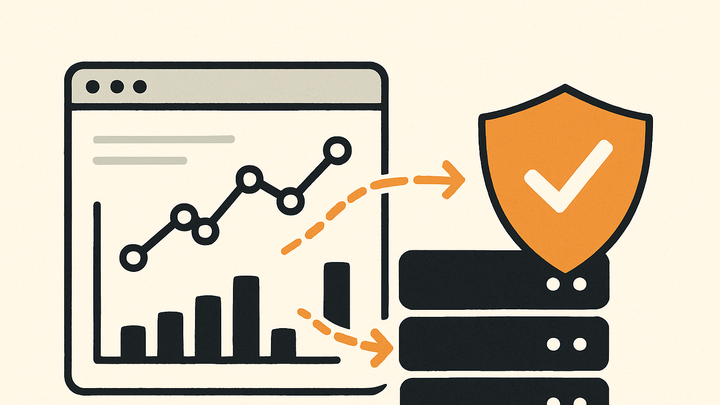Published on 2025-06-26T04:49:07Z
What is Cookie-Less Tracking? Examples and Tools
Cookie-less tracking refers to methods of collecting user interaction data without relying on third-party cookies. As browsers phase out third-party cookies and privacy regulations tighten (GDPR, CCPA), businesses must adopt alternative tracking techniques. These approaches preserve user privacy, reduce consent friction, and maintain data integrity. By leveraging first-party data, server-side collection, and event-based analytics, organizations can continue to gain insights into customer behavior. Leading solutions like PlainSignal offer completely cookie-free analytics, while Google Analytics 4 adapts with first-party cookies and modeling to fill in the gaps.
Cookie-less tracking
Cookie-less tracking collects user interactions without third-party cookies, preserving privacy while delivering actionable insights.
Why Cookie-Less Tracking Matters
With increasing privacy regulations and the decline of third-party cookies, organizations need alternative ways to monitor website performance and user behavior. Cookie-less tracking helps maintain data-driven decision-making while ensuring compliance with GDPR, CCPA, and other privacy laws. It also preserves user trust by minimizing intrusive tracking mechanisms and improves site performance by reducing cookie-related overhead.
-
Privacy regulations
Laws like GDPR and CCPA restrict the use of third-party cookies, requiring businesses to find compliant data collection strategies.
-
Gdpr
The General Data Protection Regulation demands transparent data practices and user consent for cookie-based tracking.
-
Ccpa
The California Consumer Privacy Act gives California residents the right to opt out of the sale of their personal data.
-
-
Browser changes
Major browsers like Chrome, Safari, and Firefox are phasing out support for third-party cookies, accelerating the need for cookie-less solutions.
-
Chrome
Plans to deprecate third-party cookies by the end of 2024 with its Privacy Sandbox initiative.
-
Safari and firefox
Already block many third-party cookies by default through Intelligent Tracking Prevention and Enhanced Tracking Protection.
-
-
User trust and experience
Reducing reliance on cookies can lead to faster page loads, fewer consent prompts, and improved user trust, enhancing overall site experience.
Common Approaches to Cookie-Less Tracking
Several techniques have emerged to track user behavior without third-party cookies. Each approach balances data accuracy, privacy, and implementation complexity differently.
-
First-party cookies and local storage
Using first-party cookies or browser local storage allows tracking within the same domain, which is less restricted than third-party cookies.
-
Server-side tracking
Collecting events on the server eliminates client-side cookie dependencies and reduces the impact of ad-blockers.
-
Cdp integration
Customer Data Platforms aggregate and manage first-party data from multiple sources for a unified view.
-
Data clean rooms
Secure environments where multiple parties can analyze combined datasets without sharing raw data.
-
-
Fingerprinting and device recognition
Techniques like hashing browser attributes to probabilistically identify users, although privacy concerns limit widespread adoption.
-
Canvas fingerprinting
Generates a unique identifier by drawing invisible graphics in the browser and reading the pixel data.
-
User-agent and ip hashing
Simpler fingerprinting methods combining minimal browser data points to distinguish users.
-
Implementing Cookie-Less Tracking with PlainSignal and GA4
Here are examples of how two popular analytics platforms enable cookie-less tracking: PlainSignal offers a fully cookieless integration, while Google Analytics 4 uses a mix of first-party cookies and modeling to adapt to the cookieless world.
-
PlainSignal (cookie-free analytics)
PlainSignal is designed from the ground up to collect analytics without any cookies, ensuring privacy and simplicity. Integration is as easy as adding a snippet to your HTML:
-
Integration code
<link rel="preconnect" href="//eu.plainsignal.com/" crossorigin /> <script defer data-do="yourwebsitedomain.com" data-id="0GQV1xmtzQQ" data-api="//eu.plainsignal.com" src="//cdn.plainsignal.com/plainsignal-min.js"></script> -
Data collected
Pageviews, events (clicks, form submissions), referral sources, and geolocation via IP address, all without storing cookies.
-
-
Google analytics 4 (GA4)
GA4 relies on first-party cookies and advanced modeling techniques to fill gaps when cookies are unavailable, providing robust insights across devices and platforms.
-
Enhanced measurement
Automates event tracking for scrolls, outbound clicks, site search, and more without additional code.
-
Consent mode
Adjusts data collection based on user consent, reducing reliance on cookies when tracking is not permitted.
-
-
Feature comparison
PlainSignal vs. GA4: PlainSignal offers zero configuration and full privacy, while GA4 integrates deeply with Google’s ecosystem and provides advanced modeling for cookieless scenarios.
Best Practices and Considerations
To maximize the benefits of cookie-less tracking, follow these guidelines to ensure compliance, data accuracy, and performance.
-
User consent and transparency
Maintain clear privacy policies, provide granular consent options, and log consent states for auditability.
-
Modeling and data quality
Use statistical models to estimate missing data points and regularly audit data accuracy against benchmarks.
-
Performance optimization
Leverage server-side batching to reduce client-side payload, and use CDNs for script delivery to minimize latency.
